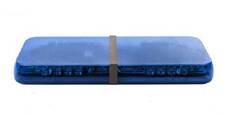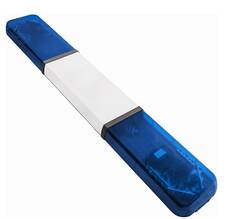Blue LED Lightbar
- further categoriesWhen a distinctive sign is used, it is always understood as a combination of sound and light signals. The light may be blue or alternating blue and red. When using the distinctive blue LED lightbar, the audible signal alternates between two different basic tones, all for the same duration, but with the possibility of continuous pitch variation. Read more...
• unique design and exceptional durability
• Only 60 mm high, 21 cm wide
• 3 leds/modul, 3W/led
• 8 modules
• Low consumption: 2A
• 4 flash modes
• Frequency of flashing: 2Hz
• Certficates: R65, R10
• The set includes all the elements needed to mount the lighting (cables, rubber pads for permanent assembly with screws and a switch)
• Lengths: 110 cm
• Blue/blue
• unique design and exceptional durability
• Only 60 mm high, 21 cm wide
• 3 leds/modul, 3W/led
• 8 modules
• Low consumption: 2A
• 4 flash modes
• Frequency of flashing: 2Hz
• Certficates: R65, R10
• The set includes all the elements needed to mount the lighting (cables, rubber pads for permanent assembly with screws and a switch)
• Lengths: 110 cm
• Blue/red
• The picture shows a blue/blue light bridge for illustration purposes! This part number and price refers to the blue/red light bridge.
• Length: 42"/107 cm; Depth: 12"/30.48 cm; Height: 2.55"/6.48 cm (without base)
• Total 6 LED modules per side (2 in front, 2 in back, 2 on side)
• 6 LEDs in inboard modules, 12 LEDs in corner modules
• The complete light bridge contains 12 LED modules (6 blue and 6 red in total)
• The modules are translucent, only the LED colour is visible when switched on
• Power supply: 12V
• House number illumination
• Fixing method: fixed, drill-in base
• 66 different flashing modes
• Compliance certificate: ECE R65, R10
• Number of LEDs: 24 3W/LED
• 8 modules
• Voltage: 12/24V
• Low power consumption: 2A
• 4 types of flashing pattern
• Flashing frequency: 2Hz
• Colour: blue/blue
• Compliance certificate: R10, R65 class 1
• Dimensions: 60 cm (length) x 6 cm (height) x 21 cm (width)
• Additional equipment: rubber pads with screws / switch box
• Operating mode: day/night mode
• Number of LEDs: 24 3W/LED
• 8 modules
• Voltage: 12/24V
• Low power consumption: 2A
• 4 types of flashing pattern
• Flashing frequency: 2Hz
• Colour: blue/blue
• Compliance certificate: R10, R65 class 2
• Dimensions: 60 cm (length) x 6 cm (height) x 21 cm (width)
• Additional equipment: rubber pads with screws / switch box
• Number of LEDs: 48 3W/LED
• 8 modules
• Voltage: 12/24V
• Low power consumption: 2A
• 4 types of flashing pattern
• Flashing frequency: 2Hz
• Colour: blue/blue
• Compliance certificate: R10, R65 class 1
• Dimensions: 60 cm (length) x 6 cm (height) x 21 cm (width)
• Additional equipment: rubber pads with screws / switch box
• Number of LEDs: 36 3W/led
• 12 modules
• Voltage: 12/24V
• Low power consumption: 2A
• 4 types of flashing pattern
• Flashing frequency: 2Hz
• Colour: blue/white/blue
• Compliance certificate: R10, R65
• Dimensions: 140 cm (length) x 6 cm (height) x 21 cm (width)
• Additional equipment: rubber pads with screws / switch box
• Special appearance, durable design
• 3 led/module, 3W/led
• 8 modules
• BPN- white centre section
• Lens colour: blue
• Multiple flashing modes
• Low power consumption: 2A
• Power supply: 12/24V
• Dimensions: 110 cm (length) x 6 cm (height) x 21 cm (width)
• The kit includes the necessary rubber mounting screw and cables for installation
• Compliance certificate: E20 R10, E9 R65
How to set up a Blue LED Lightbar
Blue LED lightbars are available in sizes between 40 and 180 cm, depending on the product type and the width of the vehicle. Mini blue LED lightbars are also available in a magnetic version with a length of 30-40 cm, but larger sizes are recommended to be mounted with a fixed, drilled-in fixing. When choosing the size of the blue LED lightbar, the width of the vehicle roof is the primary consideration. In most cases, primary blue LED lightbars are of modular design, so that the desired blue LED lightbar can be assembled according to the user's needs or the application. In Europe there is no specification on the number of modules, only that the flashing pattern must be synchronised. In many cases, the flashing pattern includes pre-programmed timings that can be selected by the user or the installer, taking into account the country's specification.
Most police flashers are available in different colours depending on the type and manufacturer, in most cases a blue and/or red LED module can be selected with a clear housing, but yellow or white LED modules are also available from manufacturers and can be used for house number, alley or passenger compartment lighting. Multicolour LED modules are also available today, which means that 2 to 3 or 4 colours can be displayed within the luminaire body.
This design allows the vehicle using the distinctive sign to provide a warning signal or traffic diversion at the scene of an accident, or to provide area lighting by switching on the white light. But you can also opt for a blue LED lightbar with a coloured drum, or the blue/red drum version, which is most commonly used by the police to emphasise the "police character" of the flashing lights, in itself indicating the presence of police to reassure motorists or pedestrians in public areas.
In addition to the light signals, the fixed drilled-in blue LED lightbar can also accommodate a siren loudspeaker. Today, it is also possible to install an integrated loudspeaker in flat design light bridges, which has several advantages. First and foremost, it is located at the highest point of the vehicle, thus providing the best sound propagation. Last but not least, it is easy to install and replace. However, the biggest disadvantage of the blue LED lightbar is that the noise in the passenger compartment is almost unbearable, which is admittedly not very pleasant for the passengers inside, so the loudspeaker is nowadays mostly located in the engine compartment.
Regulations on the use of Blue LED Lightbar
The use of this type of distinctive sign is governed by the provisions of BM Decree 13/2023 (25.V.25.), which distinguishes between users who can install it without an official permit and organisations and authorities who can only install it with an official permit. The standard MSZ 07-4009:1982 provides for the required sound pressure level of a distinctive audible warning, in this case the blue police flashing light. According to the standard, the maximum sound pressure level to be measured is 0.5-1.5 metres from the ground.
At least 103dB(A) must be measured in the area opposite and at an angle of 45 degrees to the vehicle, and a minimum of 98dB(A) must be measured 90 degrees to the side of the vehicle. Failure to do so will result in the vehicle not passing the sound pressure measurement. In addition, a blue or blue and red light bridge shall comply with photometric regulation R65 and electromagnetic compatibility regulation R10. The R65 standard guarantees that the flashing light signal itself was sufficiently visible visually. The importer must provide a declaration of compliance with these standards.
How to choose the right Blue Lightbar?
Since vehicles with blue light signals must be on the road at all times of the day and in all weather conditions, the bore of the light bridge and its socket must be able to withstand temperatures between -40 and +60 degrees Celsius. They guarantee long-lasting use, because they retain their shape and colour and must be able to withstand severe external influences. The bushings of the light bridges are made of polycarbonate, which are very hard and UV-resistant. Blue light-bridge bases, on the other hand, are mostly made of aluminium.
Both materials are lightweight, which is also important to ensure that the light bridge does not put too much strain on the vehicle body, because, for example, the roof panels of cars made today are only 0.7 cm thick. In addition, make sure that the light bridge you choose has sufficient dust and water resistance. The blue LED lightbars available in the DND Telecom online shop have different structures, which means that their height also varies. Remember that a minimum height not only ensures low drag but also reduced noise.
How easy is it to install a Blue Lightbar?
Blue LED lightbars should be installed on top of vehicles. Its location depends on the type of vehicle. You can choose between a blue LED lightbar with a magnetic base or a fixed version. In this case, it is the external wiring that needs to be professionally done. If such a flasher is chosen, the kit includes the rubber screw fixing and the necessary cables for installation. But you can also opt for a fixed blue LED lightbar with a retractable base.
In this case, however, you will need special tools and expertise, as dismantling the bodywork requires experience and the cables must be routed in such a way that they do not interfere with the driving of the vehicle. It is therefore advisable to leave this type of installation to a professional. In any case, the blue LED lightbar must be positioned in such a way that the blue indicators are clearly visible from all sides of the vehicle. This can probably only be achieved by fixing them at the highest point of the vehicle.
Are there any specific features or settings?
The flashing pattern of blue LED lightbars is mostly pre-programmable, so that the one that your user wants to apply can be chosen either by him or by the installer of the light bridge. However, both the use and installation of the light must take into account the regulations in force in the country concerned. When deciding how many light bridges to fit on a given vehicle, care must be taken to ensure that they are the right size and achieve the lighting effect required by the application. However, if more than two indicators or light-bridges are fitted on the roof of a vehicle authorised to use a differentiating sign, they must also be professionally synchronised. In this case, the control of the light bridge and the type and mode of flashing are controlled by a separate switch.
The Blue LED lightbars available in the DND Telecom webshop have 4 or 6 different flashing patterns.






